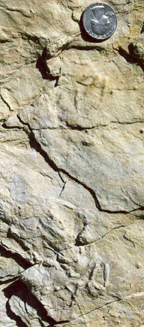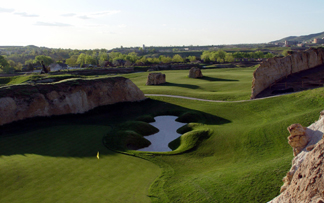 University
of Colorado researchers recently made a stunning discovery on a golf course:
several well-preserved mammal tracks from the age of dinosaurs. The footprints
are each 1 to 2 centimeters long, which correspond to animals roughly 20 centimeters
long — the average size of a rat. They are the first well-authenticated
set of Cretaceous mammal tracks in the world, says Martin Lockley, director
of the Dinosaur Trackers Research Group at the University of Colorado at Denver,
who found the tracks.
University
of Colorado researchers recently made a stunning discovery on a golf course:
several well-preserved mammal tracks from the age of dinosaurs. The footprints
are each 1 to 2 centimeters long, which correspond to animals roughly 20 centimeters
long — the average size of a rat. They are the first well-authenticated
set of Cretaceous mammal tracks in the world, says Martin Lockley, director
of the Dinosaur Trackers Research Group at the University of Colorado at Denver,
who found the tracks.  Small
tracks (far right) in the sandstone cliffs at the approach to Hole 12 at Colorado’s
Fossil Trace Golf Course (right) provide rare evidence of rat-sized mammals
from the Cretaceous. Photo of golf course courtesy of Fossil Trace Golf Course;
fossil tracks, courtesy of Martin Lockley.
Small
tracks (far right) in the sandstone cliffs at the approach to Hole 12 at Colorado’s
Fossil Trace Golf Course (right) provide rare evidence of rat-sized mammals
from the Cretaceous. Photo of golf course courtesy of Fossil Trace Golf Course;
fossil tracks, courtesy of Martin Lockley.All over the world, paleontologists have found “billions of dinosaur tracks, but so few mammal tracks,” says Spencer Lucas, curator of paleontology and geology at the New Mexico Museum of Natural History. “Maybe the Cretaceous mammals were arboreal; maybe they lived in areas where tracks wouldn’t be found, such as dry forests.” Or maybe, he says, they are so small that paleontologists have walked by the footprints immortalized in rocks countless times and simply overlooked them.
That’s precisely why Lockley returned to the Fossil Trace Golf Course near Denver, Colo. — to find something previously overlooked. He had visited the development several times in the past, like other paleontologists, to study the many dinosaur and other critter tracks, including birds and reptiles, found at the site.
In 2002, researchers found a trackway of seven footprints that they thought had been left by a lizard because one identified track had a curved toe, which lizard tracks tend to exhibit. But in 2003, Lockley spotted six tracks in a buff-colored sandstone outcrop on the golf course. On further inspection of these clearer tracks, he became convinced the trackmakers had been mammals.
The tracks most likely were made about 65 to 68 million years ago by marsupials or primitive rodent-like mammals called multituberculates, Lockley says, which were common at the time. During the Cretaceous, the region was a well-vegetated and fertile coastal plain in which soft mud and sand could preserve the tracks.
“Bona fide Mesozoic mammal tracks are extremely rare,” Lucas says. One reason paleontologists have trouble identifying mammal tracks is that there is little basis for comparison; the few mammal bones that have been found are skulls and tiny teeth, not appendages or feet. Another issue that arises in the identification of mammal tracks is the historic misidentification of tracks.
“There have been lots of mistakes made in the past, which has raised the level of skepticism,” Lucas says. Researchers have tended to make assumptions of a trackmaker’s identity based on single tracks, which is highly risky, he says.
Lockley’s discovery is a good example of the importance of analyzing multiple tracks rather than just one, Lucas says. “From sets of tracks, we can start to see patterns, such as the gait, the size of the animal, animal interactions and so on.” Researchers also can look for common foot shapes and sizes, and can differentiate front feet from back feet.
The Colorado tracks lack the elongate impression of the heel of the footprint of modern rodents, but otherwise closely resemble these animals. Ultimately, Lockley determined the animal’s mammalian heritage based on the foot size and shape and the animal’s gait, he says.
Still, Lockley is not sure that he will ever be able to fully identify the animal that left the tracks. But, says Kirk Johnson, curator and head of paleontology at the Denver Museum of Nature and Science, the Colorado finds show that there are many more tracks out there awaiting discovery. “We have found the tiniest bit of the fossil record,” he says. “We as paleontologists just need to get more people out there looking, and we’ll find more fossils.”

